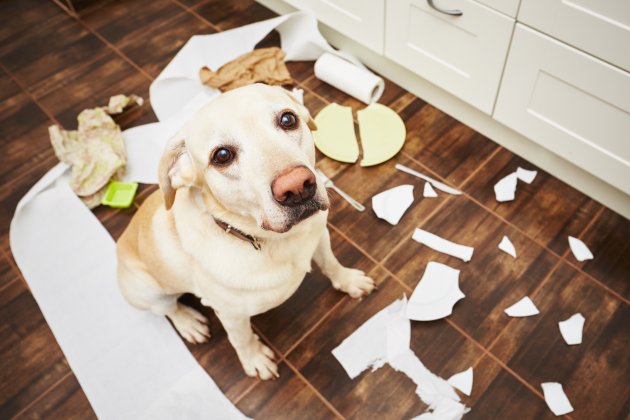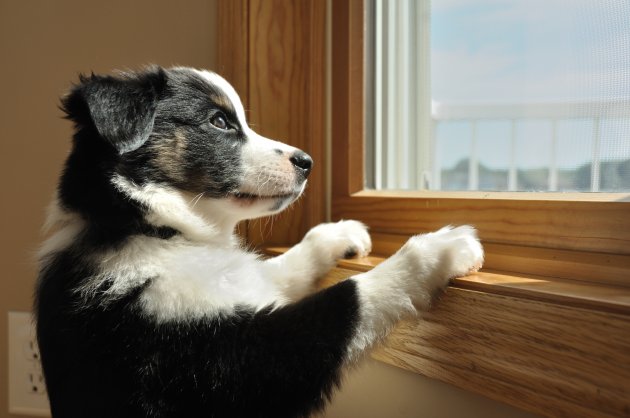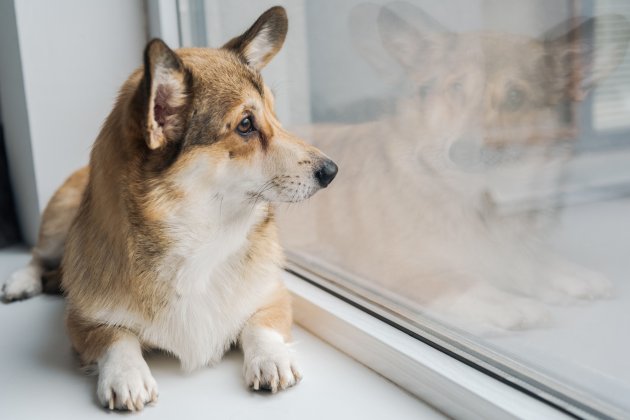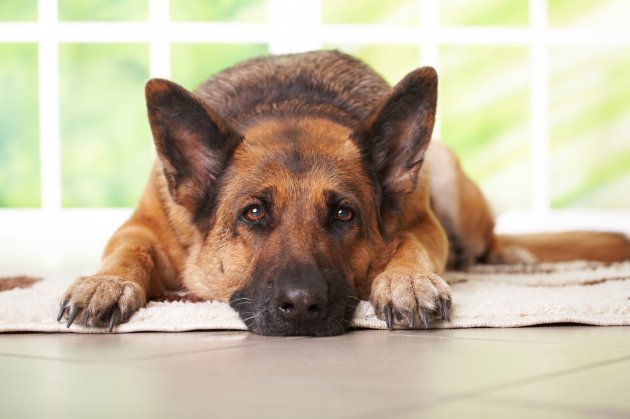We adore our furry canine companions, and even though we’d love to take them everywhere we go, that’s not always possible. We may cringe at the thought of leaving our fur baby home alone, but there are ways to make it work.
In this post, we will cover how long a dog can be left alone, what bad behaviors could occur, how to avoid separation anxiety and some safety tips you will want to have handy.
Let’s dig in!
How Long Can a Dog Be Left Alone?
There’s no hard-and-fast rule for how long you can leave your dog home alone, as it depends on the individual animal. Generally, most canines are fine for a few hours. However, puppies and senior dogs are more likely to need to relieve themselves frequently. Medical conditions, such as infections that affect the bladder, may also require you to let your pooch outside more often.
Your pet’s emotional health will also play a role in the amount of time it can spend alone. High energy breeds or those that suffer from separation anxiety shouldn’t be left alone for long hours as it could lead to destructive behavior.

What Bad Behaviors Can Happen?
Since dogs are social by nature, spending time alone can be difficult on some canines, which can result in behavioral changes such as depression, legarthy, or destructive tendencies.
This is because the animal has not developed a self-soothing coping mechanism. When a dog becomes bored or is dealing with separation anxiety, it can also manifest itself in excessive chewing, clawing, pacing, barking, and howling. Some dogs may defecate, and urinate in the home, and even try to escape.
What Is Separation Anxiety?
If your dog gets anxious when you are about to leave, starts shaking, or has excessive drooling, then it may be the first signs of separation anxiety. Dogs with separation anxiety may even try to prevent their pet parent from leaving home. Once the pet parent has gone, the separation anxiety-ridden dog will bark incessantly and display other anxiety symptoms. When the person returns (even if it's been a short while) the dog reacts as though the person has been gone for hours.
Why Do Some Dogs Get Separation Anxiety?
There’s no scientific explanation as to why some dogs develop separation anxiety; however, there seems to be a higher risk of this condition in dogs that have been placed in a shelter over those that have had a single family since puppyhood. This could be due to the canine feeling the loss of the person(s) it had grown close to.
According to the ASPCA, the following situations may trigger separation anxiety in dogs;
- Change of pet parent - being abandoned, rehomed, or placed in a shelter situation.
- Schedule change - If the dog is used to having a person home with it all day long, and suddenly that person is gone for long periods, this could trigger separation anxiety.
- Moving to a new home - the unfamiliarity of a new residence (new sights, sounds, smells, etc.).
- Missing family member - a death, divorce, or a child leaving for college can also trigger this emotional disorder.

What to Do to Help Prevent Stress in Your Dog When Left Home Alone
The first thing you should do is to determine if your dog is suffering from separation anxiety or another medical condition - your vet can help you determine the cause - however, one of the key symptoms of separation anxiety is the dog’s strong desire to escape. For example, if your pooch chews your shoes when you’re gone, this is most likely just doggie boredom, but if it claws the walls and chews the drywall, this is more likely a manifestation of separation anxiety.
To help prevent stress in your dog when being left home alone, leave him an item with your scent on it (an old t-shirt works well).
Tire your dog out by giving it a vigorous exercise session right before you leave - this can help your pooch just want to kick back and have a snooze while you’re away.
Give your pet plenty of love, snuggles, and positive reinforcement before you leave and once you re-enter the home to bolster its confidence and to assure it of your affections towards him or her.
If you tend to work long hours, or your dog is having difficulty with stress, you may find it helpful to hire a dog walker or someone that can come over and be with your pet during the day. Some pet parents have also stated that adding another dog to the home to keep Fido company works well, too.
Lastly, if you have tried many ways to alleviate your dog’s stress, and you are still having issues, there are specific sprays or diffusers that can be used that help to calm your pet down. These are effective, economical, readily available, and easy to use. Your veterinarian may also be able to prescribe medication if your pooch is extremely stressed, and he or she feels it is the best method to cope with the condition.

Safety Tips for Leaving Any Dog at Home Alone
Whether your dog suffers from separation anxiety, or not, as pet parents, we should be taking precautions to protect our pets when we leave them alone for any length of time - an ounce of prevention is better than a frantic trip to the vet.
Here are some safety tips for leaving a dog at home alone.
- Put food away - most dogs will be tempted by food left out on counter tops or tables. Be sure to put food away or in containers with tight lids.
- Secure the garbage - even if we perceive a food item as garbage, our dogs may think its a delicious treat. To keep Fido from garbage-diving, place your receptacle in a cupboard, or make sure it has a tight lid on it.
- Use a dog camera or monitor - technology has enabled us as pet parents to view, speak to, and even give our pooches a treat while we are away from our homes. These handy units allow you to check in on what your dog is up to from your cell home or computer.
- Use a crate - leaving your dog in a crate is the safest method for ensuring its safety. These units are designed for this purpose and will keep Fido confined and out of trouble while you are away.
- Separate multiple dogs (if they don’t always get along) - if you have more than one dog, and they don’t always see eye-to-eye, separating them into different rooms or crates will ensure no “disagreements” (that could lead to harm) breaks out.
- Provide your pooch with entertainment - to help reduce boredom in your dog, give it something to do while you are away. This can include a Kong toy stuffed with peanut butter, a safe toy, or an interactive toy.
- Provide background noise - leave on the television, or the radio to provide your pet with some “company.” This may even help deter would-be burglars.
- Close the windows - leaving a window open could be an invitation for your dog to jump through it or claw its way through the screen.
- Don’t leave your pet outdoors - although you may be tempted just to leave Fido outside while you are away, this is not the wisest idea. Your pet could escape, get stuck or tangled in something, encounter other animals that have wandered into the yard, hurt itself, or fall victim to overheating, dehydration, sunburn, or hypothermia in the winter months.
- Place a “Rescue Our Pets” decal where it will be noticed - if there were to be a fire, flood, or another emergency in your home, first responders know to look for and rescue your precious fur babies.

Leaving Your Dog Home Alone
Leaving your dog home alone doesn't have to be a hassle or lead to a dangerous or potentially harmful situation. Dog-proof your home by putting away food and garbage bins, give your canine something to do to pass the time with, or enlist the help of a crate, or your veterinarian for severe issues. You will also want to know the difference between "normal" canine boredom behaviors and separation anxiety so you can act accordingly.
Keeping Fido physically and emotionally safe while we are away is vital in having a happy, healthy pet.